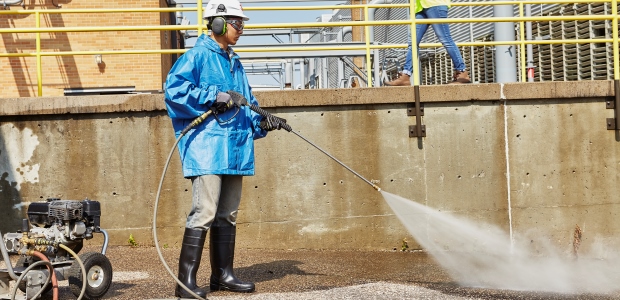
Seven Elements for a Hearing Conservation Program & You
Follow these steps to ensure you have an effective hearing conservation program.
- By Laurie Wells, Ted Madison
- Sep 01, 2017
At least 22 million employees will experience noise at work at potentially damaging levels this year. And the cost for failing to protect workers from noisy environments is not cheap, reports OSHA,1 with businesses paying out more than $1.5 million in 2016 alone.
While OSHA requires employers to provide a "continuing, effective hearing conservation program" for employees who are exposed to hazardous noise, most employers understand and respect the importance of protecting their workers' hearing.
One easy way to protect workers from work-related hearing loss is to implement seven elements of an effective Hearing Conservation Program. We'll also review ways safety managers can improve how they protect workers by engaging with them and providing more resources to help both on and off the clock. When an employer is committed to hearing loss prevention, employees may be more likely to take interest in protecting their hearing at work and elsewhere.
Seven Elements of Hearing Conservation
3M recommends seven elements for Hearing Conservation Programs (HCPs) that are based on both OSHA requirements and best practices recommendations from NIOSH. They are Measure, Control, Protect, Check, Train, Record, and Evaluate.
Measure
The journey toward creating an effective HCP begins with measurement. Through a thorough noise survey, you can:
- Identify the need for noise control
- Determine appropriate hearing protection to reduce risks
Control
Machinery and other operations can exceed the legal limits for noise exposure—but do they have to? Hazardous noise can be reduced by controlling noise at the source or limiting the amount of time a person is working in the noise. Examples of noise reduction strategies include: regular equipment maintenance, isolating workers from noise through soundproofing and noise damping, and upgrading to lower-noise tools and machinery.
Protect
Hearing protectors are effective only if they are comfortable, fit properly, and are right for the noisy job. Another factor to consider is worker communication. To help ensure each worker has an appropriate hearing protector, 3M recommends conducting individual hearing protection fit testing. The Personal Attenuation Rating (PAR) not only helps confirm a suitable protector option for the worker, but also gives an opportunity to help train the worker on proper insertion and use.
Consider engaging employees to help find new solutions. If dirty hands are the norm at your work site, consider providing a push-to-fit ear plug that requires no rolling. Employees may also recommend ear plug dispensers at more convenient locations throughout a work site.
And if they are regularly removing their hearing protectors to speak with co-workers, perhaps one with a built-in communication headset could be considered. While making the leap to higher-tech equipment may give some organizations pause, the benefits in protection and productivity can outweigh the financial risk.
When you invest in the right equipment, even at a higher initial cost, the savings in productivity, increased safety, and efficiency can far outweigh the costs.
Check
Workers who are exposed to hazardous noise, even if they are using hearing protection, must be routinely checked to make sure they are not losing hearing due to noise in the workplace. OSHA requires a baseline audiometric (hearing) test followed by annual checks. Changes in hearing are tracked over time. Employers are required to investigate and follow up hearing changes of a specified degree.
Train
Once employees are tested and provided adequate hearing protection, training is a necessary next step. Training and practice are necessary to identify when hearing protectors are needed and how to choose and use hearing protection effectively. Offer one-on-one and peer-to-peer training to address an employee's specific needs. Multiple online training and resources are available.
While this article primarily focuses on workplace hearing protection, we commend safety managers who are also taking the extra step to educate workers about protecting their hearing off the clock by offering workers take-home hearing protection. After all, noise is noise, whether it comes from a loud workplace or not. Remind workers to continue using hearing protection when doing such noisy activities as lawn mowing, leaf blowing, or using a shop vac. Suggest common sense when listening to favorite music: keep the volume at an enjoyable but safe level.
Some organizations are forward thinking and provide hearing protection education in nearby schools. By teaching today’s youth about ways to recognize hazardous workers, they are providing positive actions to prevent hearing loss for tomorrow’s workers.
For further inspiration, visit NIOSH's Safe-in-Sound Excellence in Hearing Loss Prevention Awards2 website. There you will find case studies outlining innovative ways workplaces in myriad industries have addressed protecting hearing.
Record
Protect your company and your employees in the long run by keeping accurate and up-to-date records of all aspects of the hearing conservation program. Good records can help program managers make good decisions about how to run an HCP effectively and make sure they are meeting regulatory requirements.
Evaluate
Ensure your HCP is working by conducting ongoing evaluations that incorporate employee feedback, responsibility reviews, and cost analysis. Taking this step will not only identify trends and amplify problem areas, but also drive improvement.
A New Online Resource
The 3M Center for Hearing Conservation3 is a new online resource introduced by the 3M Personal Safety Division. Safety managers can find articles, details about the seven elements of a hearing loss prevention program, videos, toolkits, fast facts, and more on hearing protection. 3M audiologists contributed to the content of the 3M Center for Hearing Conservation; resources on this site can not only help you understand the legal requirements for running an effective hearing conservation program, but also can offer ideas to help you enhance your program and provide ideas to help engage and motivate workers.
References
1. https://www.osha.gov/SLTC/noisehearingconservation/index.html
2. http://www.safeinsound.us/
3. http://www.3m.com/3M/en_US/safety-centers-of-expertise-us/center-for-hearing-conservation/
This article originally appeared in the September 2017 issue of Occupational Health & Safety.